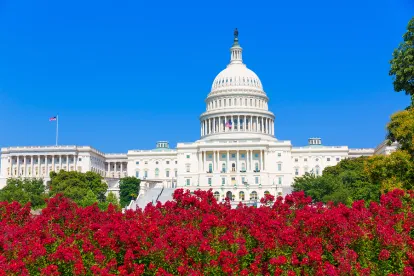President Biden has pledged to review and reverse many Trump-era environmental policies, including numerous environmental rules. With Democratic majorities in the House and Senate, Congress and the President have the ability to invoke the Congressional Review Act (CRA) to reverse certain of these Trump-era rules.
The CRA is a 1996 statute that establishes a process by which Congress can overturn “major” rules issued by federal agencies. The CRA defines major rules as those that have an annual $100 million or greater effect on the economy. Under the CRA, the newly convened 117th Congress will have a “lookback” period of 60 legislative days from the date a rule was published in the Federal Register to review the rule and vote on a joint resolution of disapproval. A simple majority in both houses of Congress is required for the measure to pass and be sent to the President. If the President then signs the joint resolution of disapproval, the rule cannot take effect, and the issuing agency would need express authority from Congress to promulgate any future rule that is “substantially the same.” Notably, no action taken pursuant to the CRA is subject to judicial review.
Some progressives and environmental non-governmental organizations (NGOs) have been critical of the CRA in the past and are reluctant to invoke the CRA to overturn rules promulgated during the Trump administration. Criticisms of the CRA include its procedural shortcuts and an expedited process, which leave little opportunity for congressional deliberation.
According to the George Washington University Regulatory Studies Center, the Environmental Protection Agency (EPA) published over 150 rules in the Federal Register during the last 60 legislative days of the 116th Congress. An executive order released on Jan. 20, 2021, identifies environmental regulations immediately targeted for repeal, suspension, or revision. The following environmental rules identified in the executive order were issued during the last 60 legislative days of the previous Congress:
-
EPA: “Oil and Natural Gas Sector: Emission Standards for New, Reconstructed, and Modified Sources Reconsideration,” 85 Fed. Reg. 57398 (Sept. 15, 2020)
This rule finalizes amendments to the new source performance standards for the oil and natural gas sector, which lifts regulations limiting methane and VOC emissions from the transportation and storage sectors of the oil and gas industry and withdraws regulations limiting methane emissions across the source category. The Biden administration appears to be targeting this rule because of its impacts on the new administration’s climate change mitigation strategy. -
EPA: “Increasing Consistency and Transparency in Considering Benefits and Costs in the Clean Air Act Rulemaking Process,” 85 Fed. Reg. 84130 (Dec. 23, 2020)
According to EPA, this procedural rule improves the rulemaking process under the Clean Air Act by establishing requirements to ensure consistent, high-quality analyses of benefits and costs are provided to the public for significant rules.
The list below includes other environmental rules, issued during the last 60 legislative days of the previous Congress, which have generated interest and controversy:
-
EPA: “Streamlining Procedures for Permit Appeals,” 85 Fed. Reg. 51650 (Aug. 21, 2020)
EPA promulgated this procedural rule to streamline and modernize EPA’s permit appeal process for permits issued under the Clean Air Act, Clean Water Act, Safe Drinking Water Act, and Resource Conservation and Recovery Act. -
EPA: “Oil and Natural Gas Sector: Emission Standards for New, Reconstructed, and Modified Sources Review,” 85 Fed. Reg. 57018 (Sept. 14, 2020)
This rule finalizes amendments to the oil and natural gas new source performance standards promulgated in 2012 and 2016. -
EPA: “Steam Electric Reconsideration Rule,” 85 Fed. Reg. 64650 (Oct. 13, 2020)
This rule revises requirements for two specific waste streams produced by steam electric power plants: flue gas desulfurization wastewater and bottom ash transport water. -
EPA: “Environmental Protection Agency Acquisition Regulation (EPAAR); Scientific Integrity,” 85 Fed. Reg. 66266 (Oct. 19, 2020)
This final rule addresses scientific integrity requirements by creating a contract clause for inclusion in solicitations and contracts when the contractor may be required to perform, communicate, or supervise scientific activities or use scientific information to perform advisory and assistance services. -
EPA: “Reclassification of Major Sources as Area Sources under Section 112 of the Clean Air Act,” 85 Fed. Reg. 73854 (Nov. 19, 2020)
This rule allows a “major source” of hazardous air pollutants to be reclassified as an “area source” after acting to limit emissions. -
EPA: “Review of the Ozone National Ambient Air Quality Standards,” 85 Fed. Reg. 87256 (Dec. 31, 2020)
This rule retains the current national ambient air quality standards, without revision, for photochemical oxidants including ozone. -
EPA: “Control of Air Pollution from Airplanes and Airplane Engines: GHG Emission Standards and Test Procedures,” 86 Fed. Reg. 2136 (Jan. 11, 2021)
This final rule establishes greenhouse gas emission standards that apply to certain new commercial airplanes. -
Army Corps of Engineers: “Reissuance and Modification of Nationwide Permits,” 86 FR 2744 (Jan. 13, 2021)
This final rule reissues 12 existing Clean Water Act Nationwide Permits (NWPs) and creates four new NWPs.






 />i
/>i

